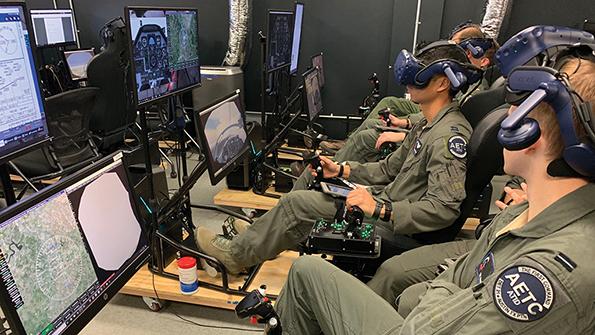
An experimental U.S. Air Force pilot training scheme is looking beyond conventional flight simulators and classroom academics in a bid to produce better pilots.
Air Education and Training Command’s Pilot Training Next (PTN) program, now in its third iteration, has the potential to transform military flight training. While it is primarily aimed at producing a better pilot, more readily equipped for new-generation aircraft, it could also be used to train them more cheaply and quickly than ever.
- Third iteration of USAF Pilot Training Next is underway
- U.S. Air Force, Air National Guard, Navy and Marine Corps and Royal Air Force pilots are enrolled
Two phases of PTN have already successfully delivered pilot graduates to training units for fighters, bombers and air mobility aircraft, and what was a largely Air Force-driven program has now widened to include pilots from the Air National Guard, Navy, Marine Corps and UK Royal Air Force (RAF).
At its heart are major changes to the scripting of pilot academics and the introduction of new synthetic training technology, explains Lt. Col. Ryan Riley, commander of Detachment 24, the PTN experimental training unit at Joint Base San Antonio-Randolph in Texas.
“Most military training, whether it is at a technical school for aircraft maintenance, firefighting or becoming a pilot . . . does not [provide] access to much of the academic content; it is doled out through a script or timeline,” Riley says.
But PTN provides the students with early access to training content prior to the beginning of a course, allowing them to learn at their own pace with a learning management system that prepares them for tests.
“We produce over 1,000 pilots every year in the U.S. Air Force, and regardless of their background—if you have 1,000 flight hours or zero time—you get the same experience,” says Riley.
“Through PTN, the student-centered learning is focusing on not only how you learn as a student but also what your background is, what your capabilities are, and then harnessing that,” he adds. “The whole point of this is to figure out the learning style of each individual and tailor it to their need.”
Supporting the new approach is the use of so-called immersive training devices (ITD), essentially high-specification but commercially available gaming computers equipped with high-definition virtual reality (VR) goggles.
The PTN students have access to 30 of the devices and can use them throughout the course, unlike with the high-fidelity and costly simulators normally associated with military training.
“The high-fidelity full-flight simulators provide high-quality training, but they are also high-demand, low-density,” says Riley. “With the ITDs, you are providing high-demand, high-density, and so now, at any point if a student is struggling with a concept, they can jump into an ITD.”
Using the ITDs, the trainees can practice maneuvers and procedures many times before they step into real aircraft.
“The students will never do something for the first time in flight; they are going to fly multiple iterations before they are actually flying in the plane,” says Lt. Col. Robert Knapp, Detachment 24’s operations officer. The students get the same amount of flight time, he notes. “We are just redistributing the focus of the learning,” he adds.
“The students are better prepared and get a lot more out of every flight hour. . . . [It is] much more valuable than the traditional system,” Riley says.
The PTN courses have the students fly around 80 hr. in the Beechcraft T-6 Texan II. Some 15 officer students and five enlisted students, along with 13 instructors, took part in the first PTN training course that ran from February to August 2018. Of the 20 students, two washed out, and one destined for F-16 training opted to come back for some T-38 training before going back to the F-16. The second course, in January-August 2019, featured students and instructors from the U.S. Air Force, Air National Guard, Navy and RAF, while the 2020 iteration brings in the first Marine Corps student.
The U.S. Army, also inspired by PTN, revealed plans last year to introduce VR simulators at its training facility at Fort Rucker, Alabama.
In the latest iteration of PTN, the program is using T-6Bs loaned from the U.S. Navy with advanced cockpits that PTN modified with an avionics system designed specifically for the curriculum.
“In the initial stages, the systems were exploratory and very buggy,” Riley says. “The flight model didn’t fly like the real airplane, and the system would crash if you opened one window too many.”
In the latest version, many of the software bugs have been ironed out, flight models have been improved, and moves are underway to increase the level of data analytics.
Agreements with the Air Force Research Laboratory and NASA are paving the way for the use of algorithms to monitor student biometrics, potentially allowing instructors to understand when the students have become task-saturated.
“PTN will continue for a few more iterations,” says Riley. But he notes that as PTN-developed technologies are subsumed into the wider training system, the program will continue to look at other new technologies to enhance the training system. “The technologies could apply to any skill set that is complex to learn,” he says.
“With the students under the VR headset, they can do an entire walk around an airplane in life-size and scale; if they want to see the electrical system, you can remove the outside skin of the aircraft,” he explains.
Riley says he is encouraged by industry’s interest in the PTN program, with some big vendors now working on developing “ITDs of their own,” he notes. “I know what we’re doing is the right way . . . but it is probably going to be something totally different five years from today,” he adds.
The third phase of PTN began in January and is expected to run until July-August of 2020.




Comments
what's the old saying, "you can have fast, cheap, or good--pick 2!" Looks like they decided to forgo 'good'.